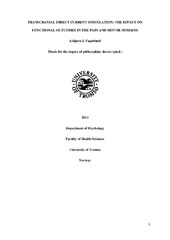Transcranial direct current stimulation: the effect on functional outcomes in the pain and motor domains
Permanent link
https://hdl.handle.net/10037/12564Date
2015-06-08Type
Doctoral thesisDoktorgradsavhandling
Author
Fagerlund, Asbjørn JohansenAbstract
This thesis describes two experiments and one clinical trial that investigated the effect of anodal tDCS over the primary motor cortex (M1) on functionally relevant outcomes, namely experimentally induced and clinical pain, and motor learning and performance on two neuropsychological tests that are commonly employed in clinical practice. The aim of Report I was to test the effect of a single session of anodal tDCS with a duration of 7 minutes and a current intensity of 2 milliampere (mA) on experimentally induced heat pain in healthy volunteers. In order to estimate the placebo effect, a no treatment condition was included in addition to active and sham tDCS. Thus, 75 healthy volunteers were randomized into 3 groups. At pretest, during stimulation and at posttest, pain stimuli were presented as thermode heat at temperatures of 43ºC, 45ºC and 47ºC. Additionally at each time point, heat pain thresholds were measured. Pain intensity was measured with a computerized visual analog scale (COVAS). Subjective stress was measured with adjective pairs from the Stress/Arousal Adjective Check List (SACL) and rated with a 0-10 numeric rating scale (NRS), and blood pressure, an indicator of objective stress, were measured with an automatic blood pressure monitor. The results indicated that, at the highest temperature, the active tDCS group reported greater pain reduction from pretest to posttest. However, the repeated measures data indicated that the response of the sham tDCS group consistently had a response pattern that were more similar to the active tDCS group than the no treatment group, indicating that the tDCS procedure might induce placebo responses that influenced the pain ratings.
The aim of the experiment in Report II was to test the effect of 20 minutes 2 mA anodal tDCS over the M1 on performance and practice effect on two commonly used neuropsychological tests measuring fine motor (Grooved Pegboard Test, GPT) and psychomotor (Trail Making test B, TMT-B) speed. In order do so, a similar study design as in Report II was employed, but with longer stimulation duration. A total of 60 healthy volunteers were randomized into 3 groups, and the neuropsychological tests were administered before, during and after stimulation. Control variables were registered to investigate the effect of overt anatomical and behavioral characteristics on the outcomes. The results indicated no effect of active tDCS on motor learning and performance. In fact all groups performed similarly at each time point. Interestingly, and uniquely for the active tDCS group, higher caffeine intake and lower inter electrode impedance predicted improved motor learning.
The aim of the randomized controlled trial in Report III was to investigate the effect of anodal tDCS on pain in fibromyalgia (FIM). A total of 48 patients, receiving active or sham tDCS, completed the study. Stimulation was administered in a similar fashion as in Report II, but over 5 consecutive days. Thus the study design was a between group design with 7 repeated measures (pretest, treatment x 5, posttest). Pain intensity, pain unpleasantness, stress, and tension (the latter 2 derived from the SACL used in Report I) were measured with short message service (SMS) text messages 3 times daily for 30 days before stimulation (mean of 30 days: pretest), during the treatment days, and for 30 days after stimulation (mean of 30 days: posttest). In addition, daily function and psychiatric symptoms were measured before and after the stimulation. The results indicated that active tDCS statistically reduced pain in the patients compared to sham tDCS. However, the effect sizes were small, and the results might indicate that the achieved pain reduction was of limited clinical importance. The overall conclusions from the experiments involving healthy volunteers (Report I and II) is that anodal tDCS over the M1 is ineffective in reducing acute pain and improving motor learning and performance. In FIM patients (Report III) 5 consecutive sessions of tDCS is capable of inducing statistically significant pain relief, and improved stimulation protocols should be investigated in order to make the treatment clinically effective.
Description
Report I: Aslaksen, P. M., Vasylenko, O., Fagerlund, A. J. (2014). The effect of transcranial direct current stimulation on experimentally induced heat pain. Available in Experimental Brain Research, 232(6), 1865-1873.
Report II: Fagerlund, A. J., Danielsen, T., Freili, J., Aslaksen, P. M. (2015). No effect of 2mA anodal tDCS over the M1 on performance and practice effect on Grooved Pegboard Test and Trail Making Test B. (Manuscript). Published version available in eNeuro,2 (4). and in Munin at http://hdl.handle.net/10037/8572
Report III: Fagerlund, A. J., Hansen, O. A., Aslaksen, P. M. (2015). Transcranial direct current stimulation as a treatment for patients with fibromyalgia: a randomized controlled trial. Available in Pain, 156(1), 62-71.
Publisher
UiT The Arctic University of NorwayUiT Norges arktiske universitet
Metadata
Show full item recordCollections
The following license file are associated with this item:


 English
English norsk
norsk
